News & Case Studies
- Details
- Written by Administrator
 A Bedfordshire, UK-based crane inspector utilised a Bluetooth-enabled, 6.5t capacity Radiolink plus load cell from Straightpoint (SP) to complete periodic inspection of an all-terrain crane recently. It was the latest in a series of similar assignments including load tests on lifting machines such as tower, loader, and other mobile cranes.
A Bedfordshire, UK-based crane inspector utilised a Bluetooth-enabled, 6.5t capacity Radiolink plus load cell from Straightpoint (SP) to complete periodic inspection of an all-terrain crane recently. It was the latest in a series of similar assignments including load tests on lifting machines such as tower, loader, and other mobile cranes.
JG Statutory Inspection Services Ltd. (JGSIS) specialises in production of reports detailing the results of thorough inspections carried out on equipment, including cranes, which is required under law to be inspected periodically. Lifting Operations and Lifting Equipment Regulations 1998 (LOLER), for example, place duties on people and companies who own, operate or have control over lifting equipment.
In the latest case study, JGSIS used the Bluetooth Radiolink plus to inspect a 1,000t capacity Demag AC 1000-9/2 all-terrain telescopic crane for Baldwins Crane Hire. The nine-axle crane boasts an integrated electronic load moment indicator (LMI); a colour display showing current operating conditions, load charts, and a fault indicator; signal lights indicating the load; and a crane data logger.
The ongoing accuracy of such equipment must be checked and verification given to the crane owner for their records. Importantly, JGSIS wasn’t testing the 1,000t capability in this instance, but only verifying that the crane’s instruments were reading the same as the load cell. Additionally, the inspection team “jibbed out” until an overload situation was detected and recorded the measurements against a tape measure.
SP recently updated its Bluetooth capability and launched an enhanced version of its popular app. Load cells now use wireless technology for exchanging data over short distances to communicate with up to eight devices, carrying the information up to 100m (328 ft.) away. Collected data can be sent onto other recipients in the form of an Excel spreadsheet or PDF report. Industry professionals have noted the ability to send reports from the same device that captures data that is already on their person—such as a mobile or cell phone.
Philip Jenkins, director at JGSIS, said: “We live in a world where speed of delivery is important to everyone. The Bluetooth system allows me to record the data, attach a PDF report, and send it onto the customer even while I’m onsite—complete with GPS location. It also saves us looking for test weights or items with a known weight when we are onsite because we can use the load cell to verify the loads. Now we can 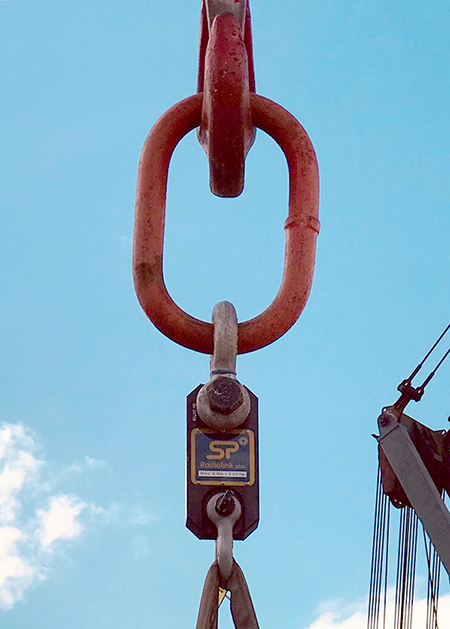 confirm the weight of anything onsite, whether it be a concrete block or loaded skip, and utilise it for our testing procedures.”
confirm the weight of anything onsite, whether it be a concrete block or loaded skip, and utilise it for our testing procedures.”
JGSIS utilises the Bluetooth-enabled device’s suitability for use over relatively short distances. The app takes its name from SP’s Handheld plus display unit, which has a range of up to 700m (2,300ft.), while the Multiple Wireless Load Cell Controller (SW-MWLC) software package displays and logs data from up to 100 SP wireless load cells simultaneously. However, this technology is better suited to more demanding, specialist applications—not the focal point of the Bluetooth concept and unlikely to be necessary for crane inspection.
Philip Jenkins added: “When I first opened dialogue with SP we discussed the handheld option but it would have added the expense of an additional unit and the Bluetooth solution is far more straightforward and cost effective. Further, it presents us as a cutting edge inspection business using state-of-the-art equipment. There are other inspection companies out there but the cost for them to tool-up their engineers with the latest equipment would be deemed prohibitive so they are still using more traditional methods.”
JGSIS, which has been trading for approximately 18 months, originally took delivery of the Radiolink plus system following an 11th-hour request to load-test a series of Hiab loader cranes. David Mullard, business development manager at SP, who oversaw the process, said turnaround of the order within 24 hours emphasises the manufacturer’s ability to work with independent testing businesses that are often summoned to site at short notice.
All of SP’s wireless load cells can now be built as a Bluetooth version as an alternative to the standard wireless version, available on request or specified at time of order.
The RLP with HHP App has just won an award presented by Speedy Hire at their Speedy Expo - Lifting Product of the Year!
Photos courtesy JGSIS:
Top: Philip Jenkins, director at JGSIS, takes a reading via Bluetooth App.
Bottom: The SP load cell is rigged below-the-hook.
- Details
- Written by Administrator
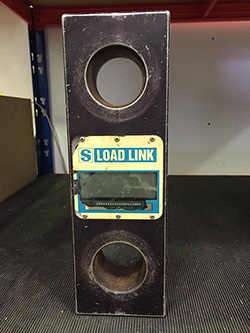 Polish marine electronics integration specialist Navinord has installed a state-of-the-art software package that includes four Straightpoint (SP) load cells on a 440t capacity floating crane, which is currently based near the Third Millennium John Paul II Bridge spanning the Martwa Wisła River in Gdansk, Poland.
Polish marine electronics integration specialist Navinord has installed a state-of-the-art software package that includes four Straightpoint (SP) load cells on a 440t capacity floating crane, which is currently based near the Third Millennium John Paul II Bridge spanning the Martwa Wisła River in Gdansk, Poland.
Its new owner renovated the crane, originally named “Consulado De Bilbao Dos” when it was built in Bilbao, Spain in 1971, last year. It is now bi-located at Marine Projects Ltd.’s shipyards in Gdansk and approx. 20km further north in Gdynia. The crane is currently known as “Conrad Consul”, taking half of its name from Marine Projects’ daughter company Conrad S.A., which specialises in the production and delivery of complete luxury sail and motor yachts.
Consul boasts two pairs of hooks, two of 100t capacity at the front and two bigger 200t capacity units behind them. However, its overall capacity is only 440t as, while four hooks can be utilised for a single lift, not all of them can lift to their full capacity at the same time. On each hook is an SP 25t capacity Radiolink plus load cell, each of which was installed during the major refurbishment of the crane last summer.
Navinord’s load monitoring system—LMSmk1—is capable of gathering data from up to 16 strain gauges, explained Piotr Cywiński, marine electronics specialist at Navinord, also headquartered near Gdansk.
In addition to the four SP units, two other devices feedback on boom line forces. All devices feed data to a master computer that can be read remotely, over the internet, and / or in Consul’s cab. The system also provides error notifications; generation of information graphs covering designated time periods; and customisable interface colours.
There are many other features of the crane itself besides, said Cywiński. Consul is equipped with navigation and communication devices, primarily for use in marine salvage, ship emergency response service (SERS), and wreck removal applications. Meanwhile, CCTV facilitates lifts out of the line of sight when it is necessary to work, say, inside a cargo haul or when another vessel might be obscuring the operator’s vision.
Consul is powered by two Voith Schneider propellers that provide propulsion and steering in one unit, while a new generator, power converters, chain blocks, lifting ropes, glass wheelhouse, and steering consoles were among other new installations.
There are two other, similar floating cranes in the region—the 330t capacity Maja and 100t capacity Conrad Goliath (the latter also belongs to Marine Projects)—but Consul is the largest. While it is primarily engaged in lifting activities in Gdansk and Gdynia, it is also capable of open sea voyages, making ports elsewhere in Poland and Lithuania accessible.
- Details
- Written by Administrator
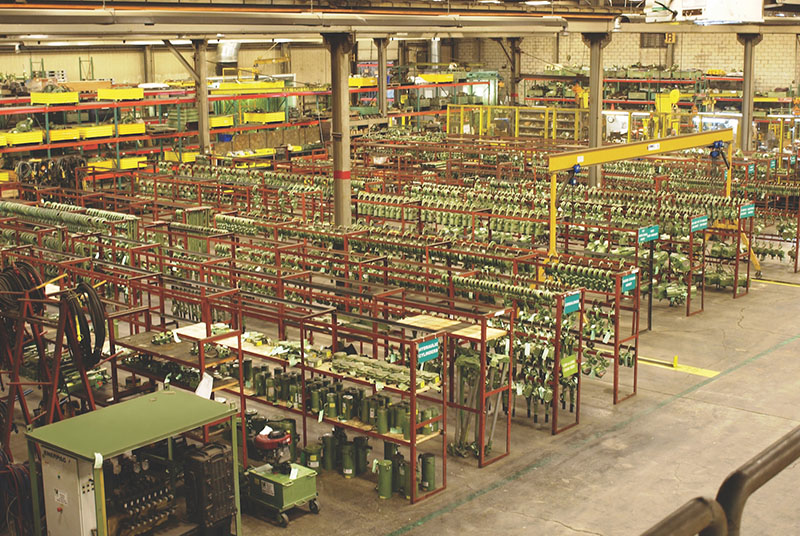
U.S. lifting equipment rental specialist Lifting Gear Hire (LGH) has initiated a major overhaul of its load cell fleet and placed a landmark order for manufacturer Straightpoint’s (SP) Radiolink plus units up to 220,000 lbs. in capacity.
The order, the value of which is not disclosed, will be delivered in a piecemeal fashion over a two-to-three-year period and will result in 23 LGH rental facilities in the U.S. and Canada stocking exclusively SP product. The Radiolink plus, which is the UK manufacturer’s top selling load cell, is capable of both weighing and dynamic load monitoring and is suited to a myriad of applications.
LGH will take a variety of models, including standard long-range (2,300 ft. or 700m) wireless versions and a number of Bluetooth units, predominantly for internal use. SP only recently updated its Bluetooth capability and launched an enhanced version of its popular app. The upgrade from Bluetooth 4.1 to 4.2 facilitated two standout improvements over the original version, namely increased range and the volume of smart devices that can be connected to a load cell.
Tony Fiscelli, president at LGH, said: “We always look for the best and most reliable product manufacturers; we feel SP falls directly in line with those high standards. Put simply, we feel they are the leader in the business sector they perform in. We look at both our vendors and customers as true partners. We value and cherish the relationships at all levels of our supply chain.”
The switch to SP follows LGH’s use of its wireless compression load cells, which offer the same range and cable-less benefits as the aforementioned Radiolink plus products. Additionally, LGH operations in mainland Europe and the UK have recently committed to SP’s range of force measurement products and reported on their robustness and suitability to rental applications.
Dan Pittman, business sales manager at LGH, acknowledged that constant evolution of the SP range was a key factor in partnering with the manufacturer. David Ayling, director at SP, said: “Recognition of our commitment to innovation and customer-driven improvement from a rental powerhouse such as LGH is testament to our ongoing success in providing load cells that make end user applications safer, more efficient, and as accurate and technologically advanced as possible.”
Pittman pointed to favorable market conditions as the first shipments arrive on U.S. soil. He said: “Business is good and the economy is growing. The forecast for the next several years gives us much cause for optimism. Heavy commercial and industrial construction are certainly marketplaces to note, and U.S. infrastructure projects will continue to require accurate information about the varied loads they lift on a daily basis.”
SP will continue to supply load cells through its existing and extensive North American distribution network.
Pictured: The order will result in 23 LGH rental facilities in the U.S. and Canada stocking exclusively SP load cells. This is LGH’s Bridgeview, IL rental center.
- Details
- Written by Administrator
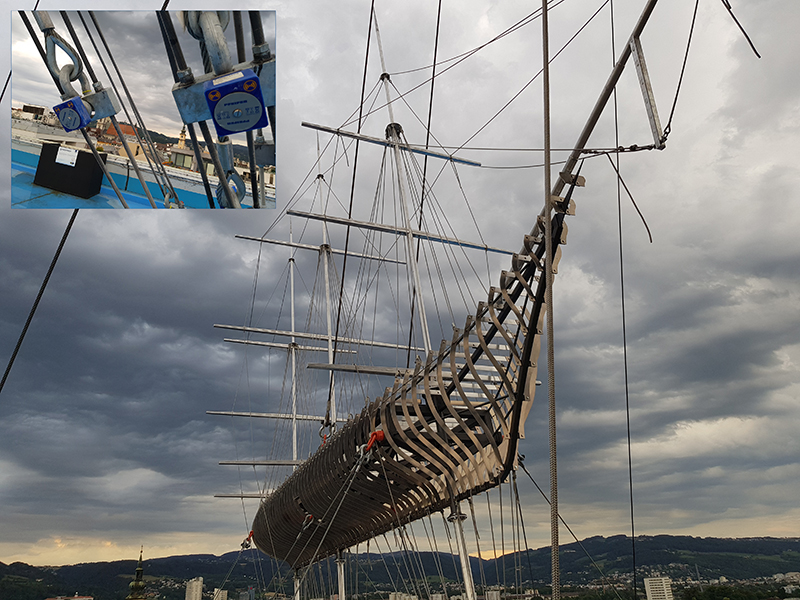
Pictured: Connection points (orange in colour in the photos) on the ship form the main rigging areas for the complex suspension project. Six 12t capacity and six 25t capacity load shackles were supplied by SP distributor Pfeifer. The load shackles were rigged strategically to communicate data via SP’s software package.
A series of 12t and 25t capacity wireless Straightpoint (SP) load shackles are monitoring loads on wire ropes supporting a 2t steel ship, suspended above the city of Linz in Austria, to symbolise the water-themed Höhenrausch cultural project, which runs from May to October this year.
Six 12t capacity and six 25t capacity load shackles were supplied by SP distributor Pfeifer, which partnered with a local engineering company to create the spectacle atop a parking area in the country’s culture-centric region. The ship is 21m long, 18m wide and “flies” at around 81m, suspended in part by a wooden tower that was originally erected in 2009 for this exhibition.
Pfeifer, a specialist in the provision of ropes for construction, entertainment, and other projects, said: “The load shackles constantly monitor and provide information about the loads. Safety is of paramount importance because the ship is suspended above an area where pedestrians view the exhibit. It was a landmark, custom project, befitting of the cultural significance of the event.”
The hull of the ship was lifted by mobile crane in one piece; the three masts were raised individually and then attached to the structure. Connection points (orange in colour in the photos) on the ship form the main rigging areas for the complex suspension project. The load shackles were rigged strategically to communicate data via SP’s Multiple Wireless Load Cell Controller (SW-MWLC) software package, designed for use on a multitude of platforms.
David Mullard, business development manager at SP, explained that the operator reads the data on a laptop in a central control station. “SW-MWLC software is used to monitor the load shackles for overloads in the rigging wires for safety reasons as visitors are able to walk directly underneath the flying boat,” he said. “The load isn’t necessarily dynamic but with wind shear the loads would certainly change. Unlike many scenarios, here the load shackles are monitoring the in-situ rigging tensions during the exhibition rather than for the lifting operation itself.”
Mullard highlighted key features of SP’s wireless load shackles including their suitability to limited headroom applications. Each load shackle is proof tested and equipped with a hard anodised aluminium electronics enclosure containing a new internal chassis providing IP67 / NEMA6 environmental protection even with the battery cover plate missing. End users benefit from a range of 700m or 2,300 ft, he added.
- Details
- Written by Administrator
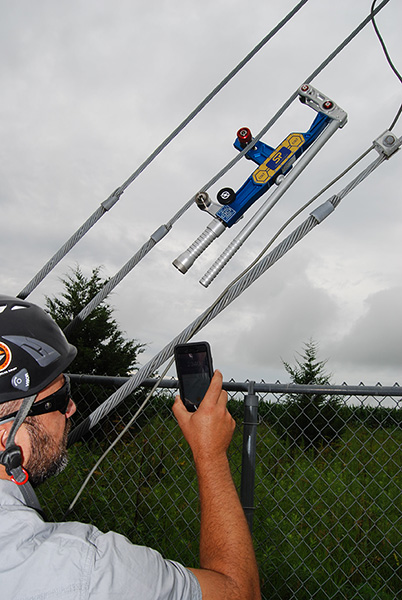 Tower erection, maintenance, and service professionals have welcomed the release of an updated version of Straightpoint’s (SP) popular product for measuring tension on static lines—the Clamp On Line Tensionmeter (or COLT). Updates to the accompanying Bluetooth load-monitoring app are among a host of new features.
Tower erection, maintenance, and service professionals have welcomed the release of an updated version of Straightpoint’s (SP) popular product for measuring tension on static lines—the Clamp On Line Tensionmeter (or COLT). Updates to the accompanying Bluetooth load-monitoring app are among a host of new features.
The COLT measures tension on wire rope up to 11,000 lbf (lb. force) / 5,000 kgf (kg force) and up to 1 in. / 25mm diameter. It clamps onto pre-tensioned wire ropes, eliminating the need for additional sheaves or tooling, as is the case with alternative solutions. An integral Bluetooth module, meanwhile, transmits tension data wirelessly to any smart device running the Android or iOS app that also contains an infinite wire rope library. Tension in wire ropes can be measured and logged within a few seconds.
Given the nature of work in this sector, where wind and other elements are of critical concern, a notable feature of the updated COLT is its ability to automatically fetch local weather conditions (temperature, wind speed, and wind direction), which is added to the data in the logging report, available on a cell phone or smart device. This is in addition to the app already grabbing GPS coordinates.
In fact, said David Ayling, director at SP, this is the new version’s standout enhancement. He explained: “Professionals in this challenging market need to be acutely aware of all hazards that might impact their work; it is a very dynamic environment. Foundations, corrosion, structural overloading, climb path obstructions, weather conditions, and much more must be monitored, logged, and accounted for. The technologically advanced COLT helps in some of these important areas and adds traceability, which is tantamount to safety.”
Ayling also pointed to a mechanical improvement to the product; enhancements to the sheave offer users even greater performance, repeatability, and accuracy, he said. Additional features are electronic and include a color-coded, wire rope database, coded to aid navigation; the ability to save a logging file as .pdf or .csv; simulate mode added to allow training and experimentation whilst in the app; a counter facility added for customers using the calibration verification rod or continuously variable transmission; and an additional datalogging facility that averages out a number of readings.
Wayne Wille, national business development manager at SP, said: “These are excellent enhancements to an already great product. They are features that our customers have asked for—and we’ve delivered.”
The COLT has already excelled in the field including applications involving tower and stack guy wires; pretensioned cable barriers; zip lines, bridges; elevators; winch rope; overhead electric transit wires; fall arrest systems; aircraft cables; and utilities projects. As expected, it has been most widely utilized in North American markets but is consumed in other geographies and is available through SP’s global dealer network.




